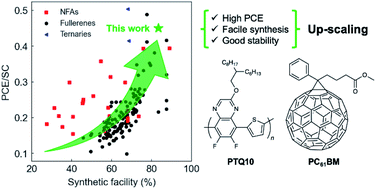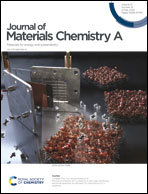Matching electron transport layers with a non-halogenated and low synthetic complexity polymer:fullerene blend for efficient outdoor and indoor organic photovoltaics†
Abstract
The desired attributes of organic photovoltaics (OPV) as a low cost and sustainable energy harvesting technology demand the use of non-halogenated solvent processing for the photoactive layer (PAL) materials, preferably of low synthetic complexity (SC) and without compromising the power conversion efficiency (PCE). Despite their record PCEs, most donor–acceptor conjugated copolymers in combination with non-fullerene acceptors are still far from upscaling due to their high cost and SC. Here we present a non-halogenated and low SC ink formulation for the PAL of organic solar cells, comprising PTQ10 and PC61BM as donor and acceptor materials, respectively, showing a record PCE of 7.5% in blade coated devices under 1 sun, and 19.9% under indoor LED conditions. We further study the compatibility of the PAL with 5 different electron transport layers (ETLs) in inverted architecture. We identify that commercial ZnO-based formulations together with a methanol-based polyethyleneimine-Zn (PEI-Zn) chelated ETL ink are the most suitable interlayers for outdoor conditions, providing fill factors as high as 74% and excellent thickness tolerance (up to 150 nm for the ETL, and >200 nm for the PAL). In indoor environments, SnO2 shows superior performance as it does not require UV photoactivation. Semi-transparent devices manufactured entirely in air via lamination show indoor PCEs exceeding 10% while retaining more than 80% of the initial performance after 400 and 350 hours of thermal and light stress, respectively. As a result, PTQ10:PC61BM combined with either PEI-Zn or SnO2 is currently positioned as a promising system for industrialisation of low cost, multipurpose OPV modules.



 Please wait while we load your content...
Please wait while we load your content...